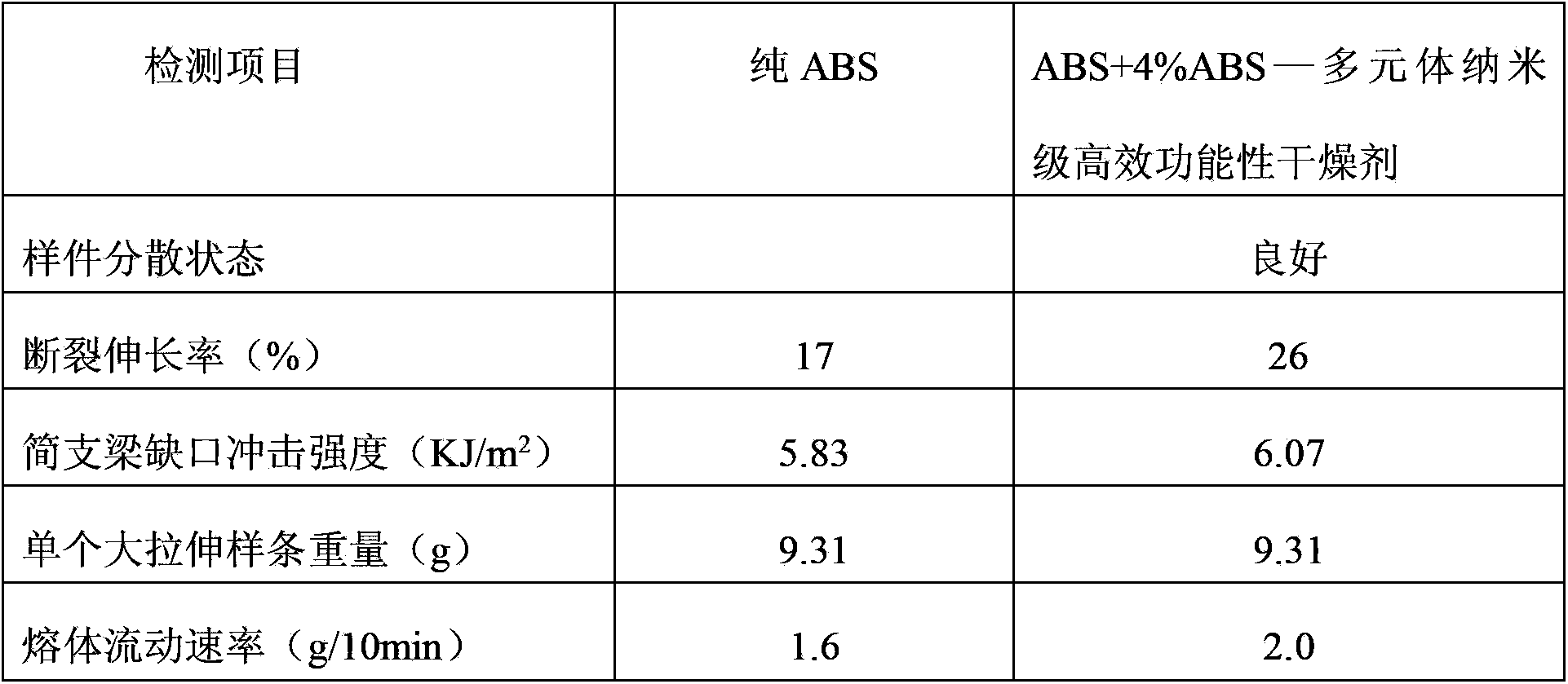Preparation method of acrylonitrile-butadiene-styrene (ABS) resin multi-component nano functional drying agent
A technology of styrene resin and butadiene, which is applied in the field of preparation of nano-environmental-friendly functional materials, can solve the problems of neglecting the negative effects of drying masterbatch, and achieve the effects of eliminating drying process, excellent aging resistance and cost reduction.
- Summary
- Abstract
- Description
- Claims
- Application Information
AI Technical Summary
Problems solved by technology
Method used
Image
Examples
example 1
[0021] Example 1, the specific material components for preparing the desiccant are respectively by weight percentage:
[0022] Nano Calcium Carbonate 66% ABS 19% Calcium Oxide 8%
[0023] Aluminum-titanium composite coupling agent 1.6%
[0024] Fatty acid polyol ester antistatic agent 0.4%
[0025] SBS (styrene-butadiene-styrene block copolymer) toughening agent 2%
[0026] Zinc stearate lubricant 0.65%
[0027] Tetrabromobisphenol A flame retardant 0.25%
[0028] Brightener 1,4-bis(o-cyano-styryl)benzene 0.06%
[0029] Antioxidant 4,4'-thiobis-(6-tert-butyl-3-methylphenol) 0.04%
[0030] DOP (dioctyl phthalate) plasticizer 2%
Embodiment 2
[0031] Embodiment two, the specific material components of preparing the desiccant are respectively by weight percentage:
[0032] Nano Calcium Carbonate 75% ABS 14% Calcium Oxide 4%
[0033] Aluminum-titanium composite coupling agent 1.8%
[0034] Fatty acid polyol ester antistatic agent 0.5%
[0035] SBS (styrene-butadiene-styrene block copolymer) toughening agent 2.3%
[0036] Zinc stearate lubricant 0.6%
[0037] Tetrabromobisphenol A flame retardant 0.2%
[0038] Brightener 1,4-bis(o-cyano-styryl)benzene 0.07%
[0039] Antioxidant 4,4'-thiobis-(6-tert-butyl-3-methylphenol) 0.03
[0040] DOP (dioctyl phthalate) plasticizer 1.5
Embodiment 3
[0041] Embodiment three, the concrete material component of preparing this desiccant is respectively by weight percentage:
[0042] Nano Calcium Carbonate 84% ABS 6% Calcium Oxide 3%
[0043] Aluminum-titanium composite coupling agent 2.2%
[0044] Fatty acid polyol ester antistatic agent 0.6%
[0045] SBS (styrene-butadiene-styrene block copolymer) toughening agent 2.5%
[0046] Zinc stearate lubricant 0.5%
[0047] Tetrabromobisphenol A flame retardant 0.1%
[0048] Brightener 1,4-bis(o-cyano-styryl)benzene 0.08%
[0049] Antioxidant 4,4'-thiobis-(6-tert-butyl-3-methylphenol) 0.02%
[0050] DOP (dioctyl phthalate) plasticizer 1
[0051] Specific implementation steps:
[0052] Step 1. Weigh 65% to 85% of nano calcium carbonate by weight, put it into the mixer, start low-speed operation, and mix at a speed of 300 to 500 revolutions per minute;
[0053]Step 2. Weigh 0.3% to 0.6% fatty acid polyol ester antistatic agent by weight, put it into the mixer, run it at a low s...
PUM
| Property | Measurement | Unit |
|---|---|---|
| water absorption | aaaaa | aaaaa |
Abstract
Description
Claims
Application Information
 Login to View More
Login to View More - R&D
- Intellectual Property
- Life Sciences
- Materials
- Tech Scout
- Unparalleled Data Quality
- Higher Quality Content
- 60% Fewer Hallucinations
Browse by: Latest US Patents, China's latest patents, Technical Efficacy Thesaurus, Application Domain, Technology Topic, Popular Technical Reports.
© 2025 PatSnap. All rights reserved.Legal|Privacy policy|Modern Slavery Act Transparency Statement|Sitemap|About US| Contact US: help@patsnap.com



